INSTITUT SUPERIEUR D'ANTHROPOLOGIE
INSTITUT OF ANTHROPOLOGY
COURS ONLINE – COURS A DISTANCE
INSCRIPTIONS OUVERTES
REGISTER NOW
FRANCE –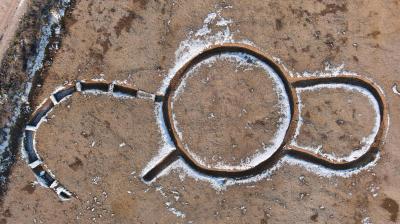 Marliens - L'occupation la plus ancienne se caractérise par un monument constitué de trois enclos imbriqués (fig. 2). Au centre du monument se trouvait un enclos circulaire de 11 m de diamètre. Au nord, un enclos en forme « de fer à cheval » de 8 m de long se couple à l’enclos circulaire et au sud, c’est un enclos ouvert qui s’adosse à l’enclos central. La présence d’une couche de graviers, observée dans le comblement des deux enclos latéraux, témoigne de l’existence d’une palissade. Les différentes coupes stratigraphiques réalisées indiquent que les trois enclos sont contemporains. Ce type de monument semble inédit et actuellement aucune comparaison n’a pu être établie. La datation reste encore incertaine cependant les seuls artefacts découverts dans les fossés correspondent à des silex taillés qui laisseraient supposer une attribution chrono-culturelle à la période néolithique. Pour plus de précision, des analyses radiocarbones sont en cours afin de préciser la chronologie de ce monument. La période campaniforme est attestée par plusieurs objets découverts juste sous la terre végétale dans une structure très arasée. Ce lot d’objets se compose de sept pointes de flèches en silex, de deux brassards d’archer, d’un briquet en silex et d’un poignard en alliage cuivreux. Des traces « d’oxyde de fer » ont été observées sur l’un des brassards correspondant à de la pyrite, élément indispensable pour allumer un feu. Cette série d’objets accompagne le plus souvent une sépulture, cependant, en raison de sa position stratigraphique située à la base des labours, cette hypothèse n’a pas pu être confirmée. Des analyses sur la composition de l’alliage cuivreux du poignard devraient permettre d’établir son origine et de nous renseigner sur les échanges commerciaux à cette époque. L’occupation durant le début de l’âge du Bronze est caractérisée par la présence de plusieurs puits qui sont les seuls témoins restant des habitats de cette période. Les analyses palynologiques et carpologiques des couches argileuses au fond de ces structures apportent de nombreuses informations sur l’environnement naturel et le paysage de la vallée dans la première moitié du second millénaire avant notre ère. Entre 1500 av. J.-C. et 1300 av. J.-C. une nécropole de cinq enclos circulaires composée de quatre enclos ouverts et un fermé s’implante dans la plaine sur une surface de 6000 m². L’acidité du sol n’a pas permis la conservation des os non brûlés si bien qu’aucune inhumation complète n’a été mise au jour, cependant des restes d’inhumations et un bûcher funéraire ont été identifiés dans les fossés du plus grand enclos ouvert dont le diamètre atteint 24 m. La datation de cet enclos se base sur cinq épingles en alliage cuivreux et un collier d’une quarantaine de perles en ambre découverts en dépôt dans son fossé. Les rares tessons de céramique recueillis dans les autres enclos confirment la datation de cette nécropole et la contemporanéité des différents enclos. Enfin, la dernière occupation correspond à une seconde nécropole distante de près de 400 m de celle précédemment décrite. Elle se caractérise par la découverte de six incinérations datées du premier âge du Fer. Les urnes, recouvertes par un couvercle, contenaient un seul dépôt osseux accompagné parfois par des parures (bracelets et/ou anneaux en alliage cuivreux et en fer). Actualité | Un secteur funéraire protohistorique à Marliens... | Inrap
Marliens - L'occupation la plus ancienne se caractérise par un monument constitué de trois enclos imbriqués (fig. 2). Au centre du monument se trouvait un enclos circulaire de 11 m de diamètre. Au nord, un enclos en forme « de fer à cheval » de 8 m de long se couple à l’enclos circulaire et au sud, c’est un enclos ouvert qui s’adosse à l’enclos central. La présence d’une couche de graviers, observée dans le comblement des deux enclos latéraux, témoigne de l’existence d’une palissade. Les différentes coupes stratigraphiques réalisées indiquent que les trois enclos sont contemporains. Ce type de monument semble inédit et actuellement aucune comparaison n’a pu être établie. La datation reste encore incertaine cependant les seuls artefacts découverts dans les fossés correspondent à des silex taillés qui laisseraient supposer une attribution chrono-culturelle à la période néolithique. Pour plus de précision, des analyses radiocarbones sont en cours afin de préciser la chronologie de ce monument. La période campaniforme est attestée par plusieurs objets découverts juste sous la terre végétale dans une structure très arasée. Ce lot d’objets se compose de sept pointes de flèches en silex, de deux brassards d’archer, d’un briquet en silex et d’un poignard en alliage cuivreux. Des traces « d’oxyde de fer » ont été observées sur l’un des brassards correspondant à de la pyrite, élément indispensable pour allumer un feu. Cette série d’objets accompagne le plus souvent une sépulture, cependant, en raison de sa position stratigraphique située à la base des labours, cette hypothèse n’a pas pu être confirmée. Des analyses sur la composition de l’alliage cuivreux du poignard devraient permettre d’établir son origine et de nous renseigner sur les échanges commerciaux à cette époque. L’occupation durant le début de l’âge du Bronze est caractérisée par la présence de plusieurs puits qui sont les seuls témoins restant des habitats de cette période. Les analyses palynologiques et carpologiques des couches argileuses au fond de ces structures apportent de nombreuses informations sur l’environnement naturel et le paysage de la vallée dans la première moitié du second millénaire avant notre ère. Entre 1500 av. J.-C. et 1300 av. J.-C. une nécropole de cinq enclos circulaires composée de quatre enclos ouverts et un fermé s’implante dans la plaine sur une surface de 6000 m². L’acidité du sol n’a pas permis la conservation des os non brûlés si bien qu’aucune inhumation complète n’a été mise au jour, cependant des restes d’inhumations et un bûcher funéraire ont été identifiés dans les fossés du plus grand enclos ouvert dont le diamètre atteint 24 m. La datation de cet enclos se base sur cinq épingles en alliage cuivreux et un collier d’une quarantaine de perles en ambre découverts en dépôt dans son fossé. Les rares tessons de céramique recueillis dans les autres enclos confirment la datation de cette nécropole et la contemporanéité des différents enclos. Enfin, la dernière occupation correspond à une seconde nécropole distante de près de 400 m de celle précédemment décrite. Elle se caractérise par la découverte de six incinérations datées du premier âge du Fer. Les urnes, recouvertes par un couvercle, contenaient un seul dépôt osseux accompagné parfois par des parures (bracelets et/ou anneaux en alliage cuivreux et en fer). Actualité | Un secteur funéraire protohistorique à Marliens... | Inrap
ALLEMAGNE – 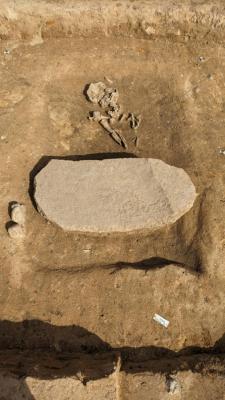 Oppin - A supposed zombie grave, dating back thousands of years, was recently unearthed in Germany, shedding light on the superstitious practices of Bronze Age Europeans. The burial site was found during an archaeological excavation near the village of Oppin, located about 100 miles southwest of Berlin. The grave, a rectangular pit, was filled with the skeletal remains of a man, who is believed to have been between 40 and 60 years old at the time of his death. His remains, which are about 4,200 years old, date back to the Bell Beaker Culture, which once inhabited a large portion of the continent. The lower half of the man’s skeleton was covered by a large stone, meaning the site is a “revenant grave,” Lochner-Rechta said. The term suggests the people who buried the man thought he might return from the dead as a “zombie,” according to MDR, a German public news station. Lochner-Rechta said this kind of grave is unusual, noting that “there is little evidence of such burial customs for the Bell Beaker culture.”
Oppin - A supposed zombie grave, dating back thousands of years, was recently unearthed in Germany, shedding light on the superstitious practices of Bronze Age Europeans. The burial site was found during an archaeological excavation near the village of Oppin, located about 100 miles southwest of Berlin. The grave, a rectangular pit, was filled with the skeletal remains of a man, who is believed to have been between 40 and 60 years old at the time of his death. His remains, which are about 4,200 years old, date back to the Bell Beaker Culture, which once inhabited a large portion of the continent. The lower half of the man’s skeleton was covered by a large stone, meaning the site is a “revenant grave,” Lochner-Rechta said. The term suggests the people who buried the man thought he might return from the dead as a “zombie,” according to MDR, a German public news station. Lochner-Rechta said this kind of grave is unusual, noting that “there is little evidence of such burial customs for the Bell Beaker culture.”
Ancient ‘zombie’ grave discovered in Germany, photos show | Miami Herald
ALLEMAGNE – 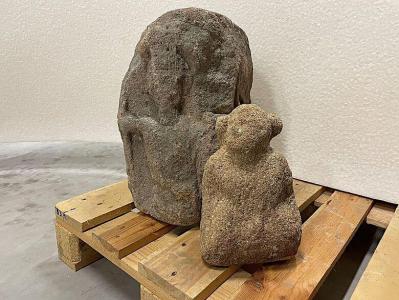 Stuttgart - Since the beginning of the year, excavations have been taking place at the Roman fort on Altenburger Steige in Stuttgart-Bad Cannstatt In Roman times, from around 100 to 150 AD, there was initially a fort for an equestrian unit, which was followed by an extensive civilian settlement until around 260 AD. During the excavations, a stone figurine from the Roman world of gods was found, which can be linked to finds from over 100 years ago. An employee of the executing company ArchaeoBW noticed an inconspicuous, mud-smeared sandstone. Upon closer inspection and after initial cleaning, the find turned out to be a 30-centimeter tall kneeling figure with a human head. Despite the weathering of the stone, you can see how her arms rest on the sides of her upper body and her hands rest on her hips and legs. However, the latter does not have a human shape, instead merging into a kind of snake body. The chief archaeologist of the LAD, Dr. Andreas Thiel, explained: The figure is a hybrid creature from the Roman-Germanic world of gods, a ‘giant.’ As comparable finds show, the figure was part of a Jupiter-Giant column. These monuments combine classical antiquity with presumably Germanic beliefs: The thunderbolt-wielding Jupiter rides his horse over a crouching figure on the ground, usually naked and bearded, as can be seen, for example, in a group from Hausen an der Zaber, in the Heilbronn district. However, the figure beneath the horse is often depicted in a pose that seems to hold up the horse. These groups of figures topped tall stone pillars erected in public squares. It is presumed that Jupiter is represented here as the god of weather and lord of the forces of nature, Thiel says. In addition to its scientific significance, the new find also has another highly interesting aspect, according to Thiel: ‘Every archaeologist is delighted when a beautiful find is made. Every excavation on the Hallschlag brings pieces of the puzzle of the Roman past of the state capital to light. In this case, we are in the fortunate position that our giant fits in with other finds that came to light in Bad Cannstatt over a hundred years ago,”. ‘We have many artifacts from Roman Bad Cannstatt in our depot. When we heard about the new discovery, we immediately thought of another part of a Jupiter Giant column: its base usually included a so-called four-god stone. In the depot of the Württemberg State Museum there is a badly damaged four-gods stone with depictions of the Roman gods Mercury, Juno, Hercules, and Minerva,’ explained Dr Astrid Fendt, Head of the Department of Archaeology and Head of Classical and Provincial Roman Archaeology at the Württemberg State Museum in Stuttgart. And Andreas Thiel added: ‘This very four-god stone comes from a well (which was located on the edge of the currently excavated area) and was found during the excavations in 1908. The inconspicuous giant could also have been lying there, but probably escaped the attention of our colleagues at the time, which is not surprising if you imagine the stone still dirty.’ Overall, it is a great stroke of luck that the recently discovered giant can be linked to a fragment that has long been stored in the Württemberg State Museum’s depot. This allows for the reconstruction of a Jupiter giant column, which was once erected near an important road junction in the Roman settlement of Bad Cannstatt. Archaeologists see this as another piece in the puzzle of Stuttgart’s rich Roman past.
Stuttgart - Since the beginning of the year, excavations have been taking place at the Roman fort on Altenburger Steige in Stuttgart-Bad Cannstatt In Roman times, from around 100 to 150 AD, there was initially a fort for an equestrian unit, which was followed by an extensive civilian settlement until around 260 AD. During the excavations, a stone figurine from the Roman world of gods was found, which can be linked to finds from over 100 years ago. An employee of the executing company ArchaeoBW noticed an inconspicuous, mud-smeared sandstone. Upon closer inspection and after initial cleaning, the find turned out to be a 30-centimeter tall kneeling figure with a human head. Despite the weathering of the stone, you can see how her arms rest on the sides of her upper body and her hands rest on her hips and legs. However, the latter does not have a human shape, instead merging into a kind of snake body. The chief archaeologist of the LAD, Dr. Andreas Thiel, explained: The figure is a hybrid creature from the Roman-Germanic world of gods, a ‘giant.’ As comparable finds show, the figure was part of a Jupiter-Giant column. These monuments combine classical antiquity with presumably Germanic beliefs: The thunderbolt-wielding Jupiter rides his horse over a crouching figure on the ground, usually naked and bearded, as can be seen, for example, in a group from Hausen an der Zaber, in the Heilbronn district. However, the figure beneath the horse is often depicted in a pose that seems to hold up the horse. These groups of figures topped tall stone pillars erected in public squares. It is presumed that Jupiter is represented here as the god of weather and lord of the forces of nature, Thiel says. In addition to its scientific significance, the new find also has another highly interesting aspect, according to Thiel: ‘Every archaeologist is delighted when a beautiful find is made. Every excavation on the Hallschlag brings pieces of the puzzle of the Roman past of the state capital to light. In this case, we are in the fortunate position that our giant fits in with other finds that came to light in Bad Cannstatt over a hundred years ago,”. ‘We have many artifacts from Roman Bad Cannstatt in our depot. When we heard about the new discovery, we immediately thought of another part of a Jupiter Giant column: its base usually included a so-called four-god stone. In the depot of the Württemberg State Museum there is a badly damaged four-gods stone with depictions of the Roman gods Mercury, Juno, Hercules, and Minerva,’ explained Dr Astrid Fendt, Head of the Department of Archaeology and Head of Classical and Provincial Roman Archaeology at the Württemberg State Museum in Stuttgart. And Andreas Thiel added: ‘This very four-god stone comes from a well (which was located on the edge of the currently excavated area) and was found during the excavations in 1908. The inconspicuous giant could also have been lying there, but probably escaped the attention of our colleagues at the time, which is not surprising if you imagine the stone still dirty.’ Overall, it is a great stroke of luck that the recently discovered giant can be linked to a fragment that has long been stored in the Württemberg State Museum’s depot. This allows for the reconstruction of a Jupiter giant column, which was once erected near an important road junction in the Roman settlement of Bad Cannstatt. Archaeologists see this as another piece in the puzzle of Stuttgart’s rich Roman past.
A sculpture of a snake-bodied Roman-German deity was discovered in Stuttgart - Arkeonews
GRECE – 
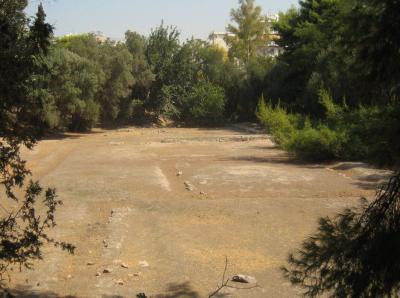 Athenes - Discovered in the 18th century, the Herculaneum papyri comprise more than 1,800 prehistoric scrolls. In the opulent Villa of the Papyri, a Roman estate in Herculaneum, Italy, they were discovered. Buried and protected by volcanic ash for thousands of years, the Herculaneum scrolls represent the only large-scale library from the classical world that has survived in its entirety. Using AI technology, scientists are now attempting to decipher the papyri. Found new words that indicated a 30% increase in text when compared to a 1991 analysis.The discovery is contained in a thousand new or differently read words of the papyrus containing the History of the Academy of Philodemus of Gadara. The discovery was revealed by papyrologist Graziano Ranocchia of the University of Pisa, presenting the mid-term results of the GreekSchools research project conducted with the National Research Council at the National Library in Naples. Papyrologist Graciano Ranocchia claimed that the findings indicate that Plato was buried in the “Academy” named after him in Athens, in a garden near the “Temple of the Muses.” This breakthrough stems from a fresh interpretation of papyri written by Philodemus of the Epicurean school, detailing the history of the Academy. Known as simply “The Academy,” or Plato’s Academy, was a well-known school in ancient Athens that was established outside the city walls in the northwest of the city in 387 BC. The legendary hero Academos is credited with giving the site its name. Reexamined Herculaneum papyri by researchers indicate that Plato might have been sold into slavery either in 399 BC following Socrates’ passing or in 404 BC during the Spartan conquest of Aegina. This refutes earlier theories that dated the incident to 387 BC, during Plato’s stay in Syracuse. There are differences in the ways that Cicero and Hermippus relate Plato’s demise: Cicero says he died while writing, while Hermippus says he died at a wedding at the age of 81 and was interred in the Academy.
Athenes - Discovered in the 18th century, the Herculaneum papyri comprise more than 1,800 prehistoric scrolls. In the opulent Villa of the Papyri, a Roman estate in Herculaneum, Italy, they were discovered. Buried and protected by volcanic ash for thousands of years, the Herculaneum scrolls represent the only large-scale library from the classical world that has survived in its entirety. Using AI technology, scientists are now attempting to decipher the papyri. Found new words that indicated a 30% increase in text when compared to a 1991 analysis.The discovery is contained in a thousand new or differently read words of the papyrus containing the History of the Academy of Philodemus of Gadara. The discovery was revealed by papyrologist Graziano Ranocchia of the University of Pisa, presenting the mid-term results of the GreekSchools research project conducted with the National Research Council at the National Library in Naples. Papyrologist Graciano Ranocchia claimed that the findings indicate that Plato was buried in the “Academy” named after him in Athens, in a garden near the “Temple of the Muses.” This breakthrough stems from a fresh interpretation of papyri written by Philodemus of the Epicurean school, detailing the history of the Academy. Known as simply “The Academy,” or Plato’s Academy, was a well-known school in ancient Athens that was established outside the city walls in the northwest of the city in 387 BC. The legendary hero Academos is credited with giving the site its name. Reexamined Herculaneum papyri by researchers indicate that Plato might have been sold into slavery either in 399 BC following Socrates’ passing or in 404 BC during the Spartan conquest of Aegina. This refutes earlier theories that dated the incident to 387 BC, during Plato’s stay in Syracuse. There are differences in the ways that Cicero and Hermippus relate Plato’s demise: Cicero says he died while writing, while Hermippus says he died at a wedding at the age of 81 and was interred in the Academy.
Italian Research Team May Have Found Plato's Burial Site in Athens - Arkeonews
INDE – 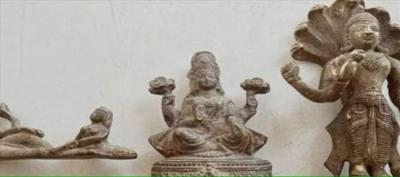 Baghanki - Three metal statues, about four hundred years old, have been found during excavation for a construction project in Baghanki village near Manesar in Haryana : one idol of Lord Vishnu, Goddess lakshmi, and a joint idol of Goddess lakshmi and Lord vishnu According to the Deputy director of the Archeology Department, according to preliminary investigation, these sculptures appear to be about 400 years old. The archeology department will now carry out further excavations to check whether more sculptures can be found at the site.
Baghanki - Three metal statues, about four hundred years old, have been found during excavation for a construction project in Baghanki village near Manesar in Haryana : one idol of Lord Vishnu, Goddess lakshmi, and a joint idol of Goddess lakshmi and Lord vishnu According to the Deputy director of the Archeology Department, according to preliminary investigation, these sculptures appear to be about 400 years old. The archeology department will now carry out further excavations to check whether more sculptures can be found at the site.
400 year old idols found during excavation in Haryana (indiaherald.com)
ESPAGNE – 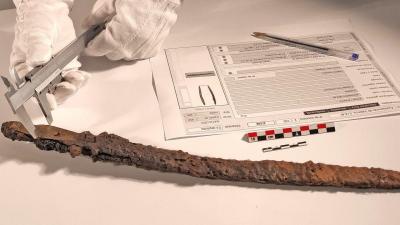
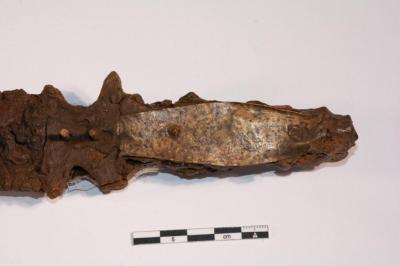 Valencia - Researchers have finally unraveled the mysteries of the historical sword discovered in Spain 30 years ago, which they named ‘Excalibur’ because of its location, which evokes similarities with the legendary sword of King Arthur. The iron sword was first discovered stuck in the ground upright in 1994 at an archaeological site in Valencia’s old town, a city on the eastern coast of Spain. This location, which is north of the old Roman Forum, has seen the rise and fall of many cultures over Valencia’s turbulent history. For the past 30 years, the sword’s origin and age have remained a point of confusion — until now. Valencia’s archaeology department decided to catalog and review the artifacts in its collection ahead of its 75th anniversary, the City Council of Valencia said in an April 22 news release. One of those artifacts was the Excalibur sword. Since its unearthing, the sword’s true age has eluded scholars. However, recent efforts by the Archaeology Service (SIAM) of the Valencia City Council have shed light on its origins, reports Horta Noticias. Through meticulous dating techniques, they have determined that the sword hails from the 10th century, firmly establishing its antiquity at over a millennium old. SIAM’s analysis indicates that this sword represents the first discovery of its kind from the Islamic era in Valencia. Swords from this period are generally scarce in Spain, particularly in Valencia, where the soil’s composition poses challenges to preservation efforts. Archeologist José Miguel Osuna, who led the research project on “Excalibur” earlier this year, found that the 18 inch-blade was from the Islamic period because of its hilt, decorated with bronze plates and notches for handling. The sword’s curved metal tip caused confusion among researchers, who thought it might have belonged to the Visigoths, but Osuna later disproved this idea. The sword’s size and the fact that it doesn’t have a hand guard suggest that a mounted warrior may have used it in the Andalusian caliphal era. Municipal technicians are clear that its origins are in the Islamic era of Balansiya, even though it may display evolutionary traits from Visigothic models. Only one comparable specimen has surfaced thus far, unearthed amidst the excavations of Medina Azahara, the illustrious caliphal city commissioned by Abderramán III in Córdoba. The Islamic period in Spain began in A.D. 711 and ended in A.D. 1492. “Thanks to the archaeology scholarship convened by the Valencia City Council, the archaeologist José Miguel Osuna is carrying out a detailed study of analysis of metallic objects that go from Roman times to the late medieval period and where a new and exceptional find has come to light, which we have called the Excalibur de Roc Chabàs to be very similar to the legendary sword of King Arthur.” José Luis Moreno, Valencia councilor for cultural action, heritage, and cultural resources, said in a press release.
Valencia - Researchers have finally unraveled the mysteries of the historical sword discovered in Spain 30 years ago, which they named ‘Excalibur’ because of its location, which evokes similarities with the legendary sword of King Arthur. The iron sword was first discovered stuck in the ground upright in 1994 at an archaeological site in Valencia’s old town, a city on the eastern coast of Spain. This location, which is north of the old Roman Forum, has seen the rise and fall of many cultures over Valencia’s turbulent history. For the past 30 years, the sword’s origin and age have remained a point of confusion — until now. Valencia’s archaeology department decided to catalog and review the artifacts in its collection ahead of its 75th anniversary, the City Council of Valencia said in an April 22 news release. One of those artifacts was the Excalibur sword. Since its unearthing, the sword’s true age has eluded scholars. However, recent efforts by the Archaeology Service (SIAM) of the Valencia City Council have shed light on its origins, reports Horta Noticias. Through meticulous dating techniques, they have determined that the sword hails from the 10th century, firmly establishing its antiquity at over a millennium old. SIAM’s analysis indicates that this sword represents the first discovery of its kind from the Islamic era in Valencia. Swords from this period are generally scarce in Spain, particularly in Valencia, where the soil’s composition poses challenges to preservation efforts. Archeologist José Miguel Osuna, who led the research project on “Excalibur” earlier this year, found that the 18 inch-blade was from the Islamic period because of its hilt, decorated with bronze plates and notches for handling. The sword’s curved metal tip caused confusion among researchers, who thought it might have belonged to the Visigoths, but Osuna later disproved this idea. The sword’s size and the fact that it doesn’t have a hand guard suggest that a mounted warrior may have used it in the Andalusian caliphal era. Municipal technicians are clear that its origins are in the Islamic era of Balansiya, even though it may display evolutionary traits from Visigothic models. Only one comparable specimen has surfaced thus far, unearthed amidst the excavations of Medina Azahara, the illustrious caliphal city commissioned by Abderramán III in Córdoba. The Islamic period in Spain began in A.D. 711 and ended in A.D. 1492. “Thanks to the archaeology scholarship convened by the Valencia City Council, the archaeologist José Miguel Osuna is carrying out a detailed study of analysis of metallic objects that go from Roman times to the late medieval period and where a new and exceptional find has come to light, which we have called the Excalibur de Roc Chabàs to be very similar to the legendary sword of King Arthur.” José Luis Moreno, Valencia councilor for cultural action, heritage, and cultural resources, said in a press release.
Unique 'Excalibur' Sword Found Upright in Ground Unearthed in Spain Holds Islamic Origins - Arkeonews
CHINE – 
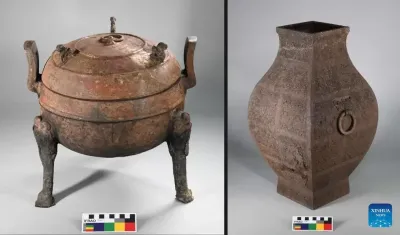 - The Wuwangdun tomb excavated in east China's Anhui Province has been confirmed as the largest and highest-level tomb from ancient Chu state dating back over 2,200 years, the National Cultural Heritage Administration said. This was reported by The Xinhua News Agency. The administration made the announcement at a press conference in Huainan City, adding that the tomb discovered in Huainan is the most structurally complex of its kind. Archaeologists focused on excavating the main vertical earth-pit tomb, confirming it as a large structure housing a wooden chambered burial area. Researchers conducted on-site protection and multidisciplinary studies of the unearthed artifacts, reinforcing and extracting fragile objects like the chamber planks, bamboo mats and lacquerware. Concurrent analyses included carbon-14 dating, wood species identification, infrared analysis of the inscriptions, and material and manufacturing studies of the lacquerware and textiles. The administration vowed to continue archaeological work, artifact preservation and interdisciplinary research at Wuwangdun, aiming to shed light on late Warring States Period Chu rituals, craftsmanship and cultural achievements. The Warring States Period ran from 475 B.C. to 221 B.C.
- The Wuwangdun tomb excavated in east China's Anhui Province has been confirmed as the largest and highest-level tomb from ancient Chu state dating back over 2,200 years, the National Cultural Heritage Administration said. This was reported by The Xinhua News Agency. The administration made the announcement at a press conference in Huainan City, adding that the tomb discovered in Huainan is the most structurally complex of its kind. Archaeologists focused on excavating the main vertical earth-pit tomb, confirming it as a large structure housing a wooden chambered burial area. Researchers conducted on-site protection and multidisciplinary studies of the unearthed artifacts, reinforcing and extracting fragile objects like the chamber planks, bamboo mats and lacquerware. Concurrent analyses included carbon-14 dating, wood species identification, infrared analysis of the inscriptions, and material and manufacturing studies of the lacquerware and textiles. The administration vowed to continue archaeological work, artifact preservation and interdisciplinary research at Wuwangdun, aiming to shed light on late Warring States Period Chu rituals, craftsmanship and cultural achievements. The Warring States Period ran from 475 B.C. to 221 B.C.
China unveils highest-level Chu state tomb excavated to date | Ukrainian news (ukranews.com)